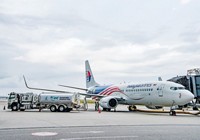Advertisement
Grab your lab coat. Let's get started
Welcome!
Welcome!
Create an account below to get 6 C&EN articles per month, receive newsletters and more - all free.
It seems this is your first time logging in online. Please enter the following information to continue.
As an ACS member you automatically get access to this site. All we need is few more details to create your reading experience.
Not you? Sign in with a different account.
Not you? Sign in with a different account.
ERROR 1
ERROR 1
ERROR 2
ERROR 2
ERROR 2
ERROR 2
ERROR 2
Password and Confirm password must match.
If you have an ACS member number, please enter it here so we can link this account to your membership. (optional)
ERROR 2
ACS values your privacy. By submitting your information, you are gaining access to C&EN and subscribing to our weekly newsletter. We use the information you provide to make your reading experience better, and we will never sell your data to third party members.
Energy
Newscripts
Canned science: WD-40 and Oscar the Grouch
by Alexander H. Tullo
October 23, 2023
| A version of this story appeared in
Volume 101, Issue 35

Canada has a WD-40 scare
Imagine a world without WD-40: a cacophony of door hinges squeaking, bolts frozen in place forever, and garden tools lost to the relentless progression of rust.
Recently, many Canadians thought they were waking up to such a dystopia. Rumors swirled on message boards from Halifax to Vancouver that the useful lubricant was facing a ban because of stringent environmental regulations soon going into effect.
But the WD-40 tale, like most rumors, was mostly untrue, with only a small kernel of wildly misinterpreted veracity.
To stem the formation of ground-level ozone, Canada is rolling out new rules to reduce the volatile organic compound (VOC) content of consumer products. But as a statement from WD-40, the company that makes the eponymous products, points out, that hardly means the end of the useful product.
“Although there are currently regulatory changes taking place in Canada, we have been aware of these regulatory changes and have been preparing for them for some time,” the company writes.
WD-40 is pretty simple stuff. According to a material safety data sheet for Canada’s WD-40 aerosol—the regular variety that comes with the little red straw—aliphatic hydrocarbons, used as solvents, account for up to 70% of the formulation. Base oils and carbon dioxide make up the rest.
Newscripts reached out to the company for more details about the change. WD-40 is swapping out some of the aliphatic hydrocarbons in the product for less volatile ones and is leaving the rest of the mixture intact.
“The reformulation does not change the ‘magic formula’—it is just as effective as it has been for 70 years,” a WD-40 spokesperson tells Newscripts in an email. In fact, the version that will be sold in Canada will be identical to the WD-40 the company has long sold in the US.
WD-40 boasts “2000+ uses.” The company put out a list of the most unusual uses it has heard about. A few stand out. “Get baked-on bird droppings off car and truck exteriors”—a big problem if you park under a tree. “Break-in baseball mitts”—a wholesome application.
The most unusual use that WD-40 has received: “Get a boa constrictor out of an engine compartment.” We hope the low-VOC version works just as well for this application.
United gets a Muppet mascot

United Airlines could not have found a better mascot to promote its sustainable aviation fuel efforts: Sesame Street garbage can resident Oscar the Grouch.
Sustainable aviation fuel (SAF) has become a big topic in the aviation industry, which is responsible for 2.5–3.5% of greenhouse gas emissions, according to Our World in Data.
There are a few different routes to the production of SAF—all based on renewable feedstocks. The most popular process is using hydrotreated esters and fatty acids (HEFA) to convert fats and oils into jet fuel. Another up-and-coming approach is gasifying organic waste and converting the synthesis gas—hydrogen and carbon monoxide—into long-chain hydrocarbons via a Fischer-Tropsch reaction.
Enter: Oscar
This year, United made the Muppet its chief trash officer for a series of videos highlighting the promise of SAF. In these spots, which have been playing on United planes before flight, United gives Oscar a big corner office littered with apple cores, a birdcage, a basketball, an old typewriter, and other junk. He sits behind the desk in his trademark galvanized steel trash can. His job, a United employee tells him, will be to “get more people passionate about trash.”
The ads explain how SAF can be made from old cooking oil, grease, woody biomass, and agricultural slop. “Your banana peel could one day help fly a plane,” one United worker tells Oscar.
The ads mirror United’s efforts in SAF. United is an investor in Fulcrum BioEnergy, which started up a plant that makes synthetic crude oil from gasified trash. United is also buying SAF from the Finnish refiner Neste, which operates the HEFA route.
The fine print: SAF makes up only 0.1% of United’s fuel consumption—but the company already seems to be getting public relations mileage out of the program.
Please send comments and suggestions to newscripts@acs.org.





Join the conversation
Contact the reporter
Submit a Letter to the Editor for publication
Engage with us on Twitter